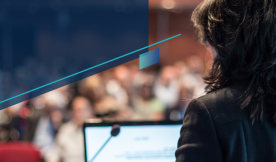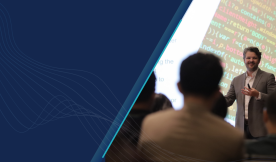Fire, Time Travel, and Mars: a Q&A with Vamekh Kherkheulidze, founder of Elven Technologies
The Elven Technologies team won the top prize at the GIST Regional Startup Training Caucasus in 2019. The intensive training program is designed to help improve business ideas, perfect pitches, and showcase innovations in front of business leaders, policymakers, academics, and chief science advisors from around the region. Kherkheulidze was subsequently selected for the GIST Business Incubation program that same year. The 2019 GIST Business Incubation program provided entrepreneurs with exposure to the U.S. market and startup resources. While in residence with the program, participants worked on refining their ideas, building their business plans, and finding the right market for their product.
This conversation between Vamekh Kherkheulidze and VentureWell’s Genesis Lodise was conducted January 26, 2021 and was edited for clarity. VentureWell is the GIST initiative’s primary implementing partner.
GIST: You started in the medical field, as a doctor. How did you make the transition from lab to market? How did you exit the medical field and become an entrepreneur?
Vamekh Kherkheulidze: My whole family are medical doctors so that seemed right for me to go into that field. I enjoyed it, and both taught and practiced. Including schooling, I worked in medicine for about 12 years. During this time, like a hobby, I was trying to invent new stuff. I had this idea in medical school to build an exoskeleton but someone said “The laws of physics say that your design won’t work.” But then I was working in Israel and I saw that the Georgia Innovation and Technology Agency (GITA), which is a governmental organization that funds startups, was offering grants so I rushed back home and applied and now I’m building an exoskeleton.
GIST: So you got your start with this project through GITA? Do they have facilities there for the level of manufacturing your project needs?
VK: Yes, and no. It's basically very light machinery. We started on their machines but quickly realized the product we were making needed some very specific resources outside of that. They didn’t have anything like what I got to see at MHub in Chicago during my accelerator stay with GIST Business Incubation.
GIST: Right, I remember you mentioned that the experience in Chicago allowed you to test machines that you wouldn't have been able to do in Georgia. And then you would know what to buy when you got back. Have you maintained any connections with the people at MHub in Chicago?
VK: Yeah, especially the people who actually taught me how to use those machinery. It’s a great network of engineers. Anytime I have questions, I just have to ask, and they have a very friendly network. I get plenty of answers. Whenever I need to know something special about the machinery, I just text the guy who taught me there and he gives me a hand.
GIST: When you were first forming your startup did you have partners in mind already or did you have to go out and find partners?
VK: I had one guy in mind. Basically, in Georgia, there were very few people here who did tech in any way, and especially hard tech like good mechanical engineers. And hardly any young engineers. We have some experienced people from the Soviet era, who are like 60- or 70-years-old now and aren’t as interested in taking new risks. So anytime anybody needs to build hardware everybody thinks of one guy. So I had that guy in mind with my previous startup, which was a virtual reality simulation for surgical students. We were partnering with his startup who was building a VR interactive glove and when they failed, we both failed. But when I started working on this new startup I knew he had to be the CTO. He never solves any problem by Googling it. He goes off and thinks about it and that’s extremely handy when you're inventing something that doesn't exist.
GIST: So your first startup failed?
VK: Oh, yeah. That was my first startup. And even after that, I was still in medicine in Israel and I was building a wireless stethoscope. That was the second product I came up with. It didn't get funded. But it will still work! And as soon as I get this new Computer Numerical Control (CNC) machine I'm just going to build it myself just to prove that it works. Never give up!
GIST: Tell us about your current startup and the product you have developed.
VK: Yes, the first product is a flameproof firefighter uniform. And it has two major breakthroughs. Standard firefighter uniforms are expensive and heavy and offer limited protection, approximately eight to 10 seconds of protection in direct flames. And they weigh 30 to 40 pounds. So our first breakthrough was to bring the weight down to about 16 pounds.
GIST: Wow!
VK: And… provide 80 seconds of protection. That’s almost 10 times longer protection with half the weight, which is crazy and it costs approximately the same. And the cost will just decrease as we sell more and refine it. The next goal is to test the uniform and it's quite hard to test it because there are only several companies in the world who have the facilities to test these uniforms. There’s a hightech mannequin with sensors and a burning chamber. It’s too expensive to use theirs so we're building our own.
GIST: That’s such an entrepreneurial mindset. “This already exists but it’s too inconvenient for us to go use so we’re just going to build it ourselves.”
VK: Yeah, let's build it in-house, test it ourselves, with better tech than those other guys have, and we might even be able to turn it into a new product because we built a better way of testing firefighter uniforms.
GIST: And speaking of that firefighter suit…. (shows photo at beginning of this article)
VK: Oh, yeah. That's a cool photo.
GIST: So in theory. Could I wear one of these outfits and drop out of low earth orbit and not burn up?
VK: Yes. But…I haven't gone completely, scientific crazy with the math just to prove it on paper, but yes, it sounds like it. The temperature on the surface in the picture you just showed is about 1200 degrees Celsius which is 2000 Fahrenheit. And that's approximate the temperature on the surface of something that's falling through the atmosphere. So it mainly depends on the timing. How long can it last at that temperature? If it takes longer than just a minute or 80 seconds then the solution would be active cooling. Which we have already built, we have already tested. It's the second product which will be an upgrade for our current suit. So, yeah. In theory you can fall out of the ISS (International Space Station) and just redirect yourself towards the earth and burn up and just stop with a parachute and land.
GIST: Yes! I want to see it.
VK: I want to be the guy who does that. It's gonna be real fun.
GIST: I noticed on the wall behind your workstation is a big poster of Mars. Is there some personal significance for you for the Red Planet?
VK: To be frank, it's not a personal significance. But if you ask me as a scientist, I would say that we need to get multi-planetary as soon as possible because time is ticking. But it could be Mars or Venus or it can be the moon. I'm not sure about the whole “changing the planet and making it green” part, though.
GIST: Terraforming?
VK: Yeah, I’m not sure about terraforming because it's going to take so much more time than our lifetimes and I'm not sure that we're going to stay on the same path that whole time. The whole technology we're developing for terraforming might be so slow that we might invent something that gets us to the next galaxy or X star in two days. So you just leave Mars and go to the new, already habitable planet. But definitely the first step is Mars.
GIST: So, you were building your firefighter outfit. Was there a moment where you looked at it and it suddenly dawned on you that this could be repurposed for a space suit? Was there a light bulb that went off?
VK: It went backwards, actually. Elven technologies was founded to build a space suit. Elon Musk proved that we need to shoot for Mars and because of reusable rockets, it will happen in our lifetime. Because of that, the big new startups, as well as governments, started working on new space stuff. People are working on new fuels, and how to grow potatoes in space--it's very complex work that humanity is doing right now.
But I realized that nobody's building a space suit. And it also needs to be done. The current space suits were built in the Apollo missions in the early 60s and they were last upgraded in 1974. That's very old, very heavy technology to take with you to Mars. It’s not going to work. You need an absolutely new type of suit.
We asked ourselves what a new space suit would consist of. And we saw that there are six major technologies involved so we said let's take each technology and absolutely reinvent it.
But we knew we wouldn’t be able to do this--three guys in a garage in Georgia. So we decided to try and do just one. And then our idea was to sell that product and make enough money to jump into the second technology. Eventually we’d get to the third, forth, fifth, and sixth technologies and then we’d have our space suit.
GIST: 2020 was a big year for the world. But it was also very specifically a big year for Elven Technologies.
VK: At the end of 2019 I was in the U.S. (with the GIST Business Incubation program) and when I came back to Georgia we didn't have any money left. I had been furiously fundraising all fall while I was in the U.S. but no luck. I had a chance to join GITA for a trip to Silicon Valley for a week. There, I pitched to a large group of investors but didn't get anything. When I came back, just before the COVID lockdown, we organized our first big investors meeting in Georgia where we would do this demo, like the burning test as you have in the picture. The week we were to do the meeting, the lockdown started.
We basically failed. We stopped working on the uniform because we couldn't leave home. We redirected ourselves to building new facemasks. These would later become a helmet for the firefighter uniform, so it wasn’t a total loss. In September, we restarted the fundraising. We brought on a costume designer, offered her a stake in the company, and that led to our first ever prototype that she designed. It looks like an actual product. Visually you cannot distinguish it from a regular uniform. That really influenced people a lot.
We showed progress after the lockdown and that progress was very important. When there was nothing working, you couldn't buy anything in Georgia, we still showed progress. That helped people believe in us. We raised $45k from family and friends. I was pitching our product on Zoom in the morning, in the evening, very late at night. Finally someone from Silicon Valley called us and said they were interested and wanted to invest. They actually became the lead investor and determined the whole valuation of the shares. We already had applied for a GITA matching grant and in the end we closed with around $160k.
In September we didn't have any money left and we were thinking about giving up but we didn't and now, here we are.
GIST: That goes back to what you were saying earlier--never give up.
VK: Yeah, that's exactly what we told ourselves. We had worked so hard for so long and we were so close. Our technology was working. We just had to show other people and get them excited.
GIST: You wrote an article last year for Entrepreneur Magazine on the world’s response to COVID. You had some interesting conclusions--tell us about that.
VK: Yes, as a doctor they asked me to write something on COVID. We were in lockdown with an economic recession. The earth fell into a panic. The whole planet closed down. Then we started thinking about the solutions. Science and tech people were working together, exchanging data to make sure we all know as much as possible about COVID. Humanity is very good with exchanging data. We have the Internet, so we don't need to be in the same room with each other anymore.
But we realized that the major problem we faced was that humanity wasn't ready for manufacturing the hardware to tackle this issue. Software-wise, we're absolutely ready for this. But manufacturing hardware has become second to software. Silicon Valley, which is still the software hub of the world, has stopped being the hardware innovation hub. Only a few countries really know how to innovate in hardware today because they have the machinery, they have the workforce, they have the scientists and engineers who know how to build. That's why there were no new kinds of helmets or face masks and stuff. Nobody in Georgia thinks they will solve this issue with a custom made aluminum part because you can’t get it done quickly. But in say, China, they make a call, ask someone about this type of part, they can make a prototype by tomorrow.
GIST: I think a lot of us felt that. We have the software innovation, but we do not have the manufacturing innovation that we used to and I think many countries are realizing the value in having a stronger manufacturing sector.
VK: Yeah, there was a big pivot for the whole world. An innovation pathway that all humanity had to shift toward regarding hardware.
GIST: You taught a course this past year on design thinking. How did that go?
VK: Yes, that was the first time I had done any teaching on a non-medical subject. The subject of design thinking for business and entrepreneurship is a new thing in Georgia. I did a 30 minute design thinking lecture for virtual learning that is being tested in Georgia.
GIST: Did you feel that you were giving back to the entrepreneurial community?
VK: Yes, but I really try to do that all the time. I have calls with five or six people for an hour and they just asked me questions about their startups.
GIST: I think that’s called mentoring.
VK: Kinda, yeah. Mainly telling them about the mistakes that we have already made. Whenever you speak to like-minded people, it might just trigger you to find the solution yourself. Talking to people with multiple different kinds of ideas, you just open your brain to the new ideas which might help you solve your own problems.
GIST: Both the teaching and the mentoring aspects are really important for early-stage innovators because there are so many things they don't know. Having a mentor, someone with a bit more experience, who can give you better insights into how to make decisions, can make a big difference.
VK: The hardest part for people in the university, or just beginning their startup, is to see a bigger picture. They might be studying specific things but they don't understand where it fits in the bigger picture. The reason I decided to start teaching was to change the things I didn't like when I was a student. Show them the bigger picture.
GIST: If you were to travel back in time to meet yourself maybe 10 years ago, what advice would you have for yourself in terms of your entrepreneurial journey and the lessons that you've learned along the way?
VK: To be absolutely frank, I wouldn’t even see myself. I wouldn’t interfere at all. I've made a lot of mistakes in a lot of different fields. I believe that every mistake is a lesson. So if you don't make mistakes, you don't learn. Plus, if I tell myself something I might mess all kinds of things up. Time travel is complicated.
GIST: Fair enough. Let me rephrase the question just a little bit. What advice do you have for STEM innovators, who are just entering their journey in entrepreneurship?
VK: When you choose what you're going to do and what you want to accomplish, think in terms of maybe 10, 20, 30 years. What do you want your accomplishments to continue accomplishing after you’ve gone? Find people who are as crazy as you are. The more crazy people you have together, the better the solutions you are going to come up with. And of course, it's very important that you don't give up. Your work will be very hard but don’t let that stop you.


